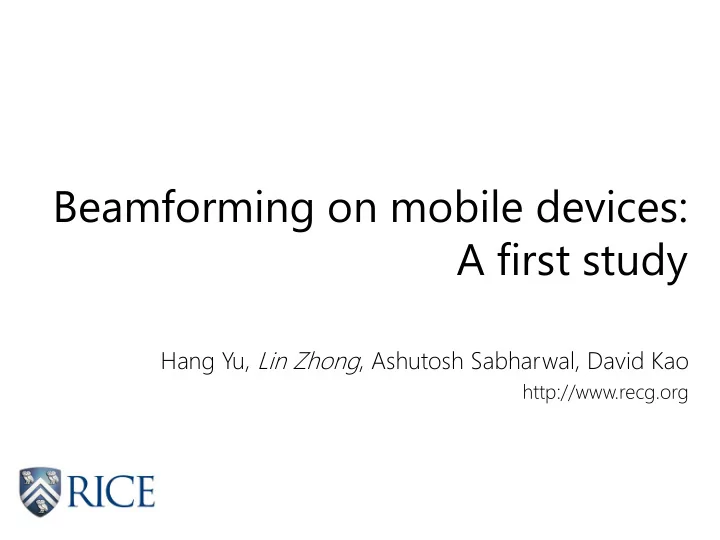

Beamforming on mobile devices: A first study Hang Yu, Lin Zhong , Ashutosh Sabharwal, David Kao http://www.recg.org
Two invariants for wireless • Spectrum is scarce • Hardware is cheap and getting cheaper 2
Passive directional antennas 3.2 cm 3.2 cm Ardalan Amiri Sani, Lin Zhong, and Ashutosh Sabharwal, "Directional antenna diversity for mobile devices: characterizations and solutions," in Proc. ACM MobiCom , September 2010. 4
Findings: ~3 dB gain • Multifold throughput increase at network edge • ~50% TX power reduction at network center 5
Can we go beyond 3 dB? 6
Beamforming? Studied in the past for use on cellular base station, 802.11 access • points, vehicles, and even wireless sensor nodes, e.g., MobiSteer (MobiSys’07), R2D2 (MobiSys’09), DIRC (SIGCOMM’09 ) 7
Beamforming primer 8
Beamforming primer Fixed transmission power
Beamforming primer Fixed transmission power
Beamforming primer Fixed transmission power
Beamforming primer Fixed transmission power
Is beamforming practical? • Beamforming • Mobile devices – Antenna array – Small form factor – Narrow beam – Rotate and move – Power hungry – Battery powered 13
Form factor? 7 4 antennas Peak beamforming gain (dB) 3 antennas 6 2 antennas 5 4 3 2 1 0 0 0.1 0.2 0.3 0.4 0.5 Antenna spacing (wavelength) 0.3-0.4 λ : 4.5-6 cm at 2 GHz
Form factor! 18 cm 6 c cm 24 cm 12 cm 0.3-0.4 λ (4.5-6 cm at 2 GHz) 15
Rotation? Client Node Infrastructure Node 16
Rotation? Indoor Max Beamforming gain (dB) Static 6 90d/s 180d/s 3 0 N=2 N=4 CSI estimation every 100 ms
Rotation! Indoor Max Beamforming gain (dB) Static 6 90d/s 180d/s 3 0 N=2 N=4 CSI estimation every 10 ms
Power? (uplink only) P Circuit P PA =P TX / η DAC Filter Mixer Filter PA 1 Baseband Signal Frequency N Synthesizer P Shared DAC Filter Filter PA N Baseband Signal Mixer P = P shared + N∙P Circuit + P TX / η 19
Tradeoff No. 1 P= P shared + 1 ∙P Circuit + P TX / η Fixed receiver SNR
Tradeoff No. 1 P= P shared + 2 ∙P Circuit + P TX TX / η Fixed receiver SNR
Tradeoff No. 1 P= P shared + 3 ∙P Circuit + P TX TX / η Fixed receiver SNR
Tradeoff No. 1 P= P shared + 4 ∙P Circuit + P TX TX / η Fixed receiver SNR
Tradeoff No. 1 • Optimal number of antennas for efficiency 𝑂 𝑝𝑞𝑢 = 𝑏 ∙ 𝑄 𝑃 /𝑄 𝐷𝑗𝑠𝑑𝑣𝑗𝑢 − 𝑐 ∙ 𝑄 𝑃 24
Hardware is cheap & getting cheaper P = P shared + N∙P Circuit + P TX / η Transmitter Power Consumption (mW) 1200 SISO 2x2 MIMO 1000 800 600 400 200 0 2002 2004 2006 2008 2010 Year Sources: IEEE Int. Solid-State Circuits Conferences (ISSCC) and IEEE Journal of Solid-State Circuits (JSSC)
Power! • Beamforming with state-of-the-art multi-RF chain realization is already more efficient! • Tradeoff No. 1 is increasingly profitable!
Beyond a single link 27
What the carrier wants: Use all your antennas! 28
What you want: 𝑂 𝑝𝑞𝑢 = 𝑏 ∙ 𝑄 𝑃 /𝑄 𝐷𝑗𝑠𝑑𝑣𝑗𝑢 − 𝑐 ∙ 𝑄 𝑃 29
Tradeoff No. 2 • Network capacity vs. client efficiency 30
How can clients figure out its N without talking to each other? 31
BeamAdapt • Distributed algorithm to minimize TX power under uplink capacity constraints – No explicit inter-client cooperation – Iterative – Guaranteed to converge – Converge in a few iterations in practice – Converge to a good solution in practice • Can be built on top of uplink power control in cellular networks 32
WARPLab-based prototype Infrastructure Node 1 Infrastructure Node 2 Ethernet Router Uplink Uplink (Wireless) (Wireless) Client Node 1 Client Node 2 Laptop with MATLAB 33
Received SNR stable Client Node 2 20 SINR (dB) 10 0 -10 0 5 10 Beamforming size Time (s) 4 3 2 1 0 5 10 Time (s) Link SNR constraint: 5 dB 34
Power close to optimal 5dB 2000 Power consumption (mW) BeamAdapt Genie-aided 1500 1000 500 0 I/S I/M O/S O/M I: Indoor O: Outdoor S: Stationary M: Mobile / Rotational Link SNR constraint: 5 dB
4km 4km UMTS; Client movement: 0-70 mph; Client rotation: 0-120 °/s
Power reduced Client Power Consumption (mW) 1000 Beamforming/Omni BeamAdapt 800 600 400 200 0 N=1 N=2 N=4 N=8 CBR traffic
Network throughput maintained 5 x 10 2 Beamforming/Omni Network Throughput (b/s) BeamAdapt 1.5 1 0.5 0 N=1 N=2 N=4 N=8 CBR traffic
Conclusions • Beamforming is feasible for mobile devices • Lower-power uplink for mobile devices • Distributed optimization feasible
Looking forward • Benefits of beamforming orthogonal to other spectrum efficiency technologies such as network MIMO • Network capacity implications
Treating interference as noise Strong interference regime: Far from optimal from information theoretic perspective
Treating interference as noise Weak interference regime: Existing architecture yields close to optimal capacity
http://www.recg.org
Recommend
More recommend